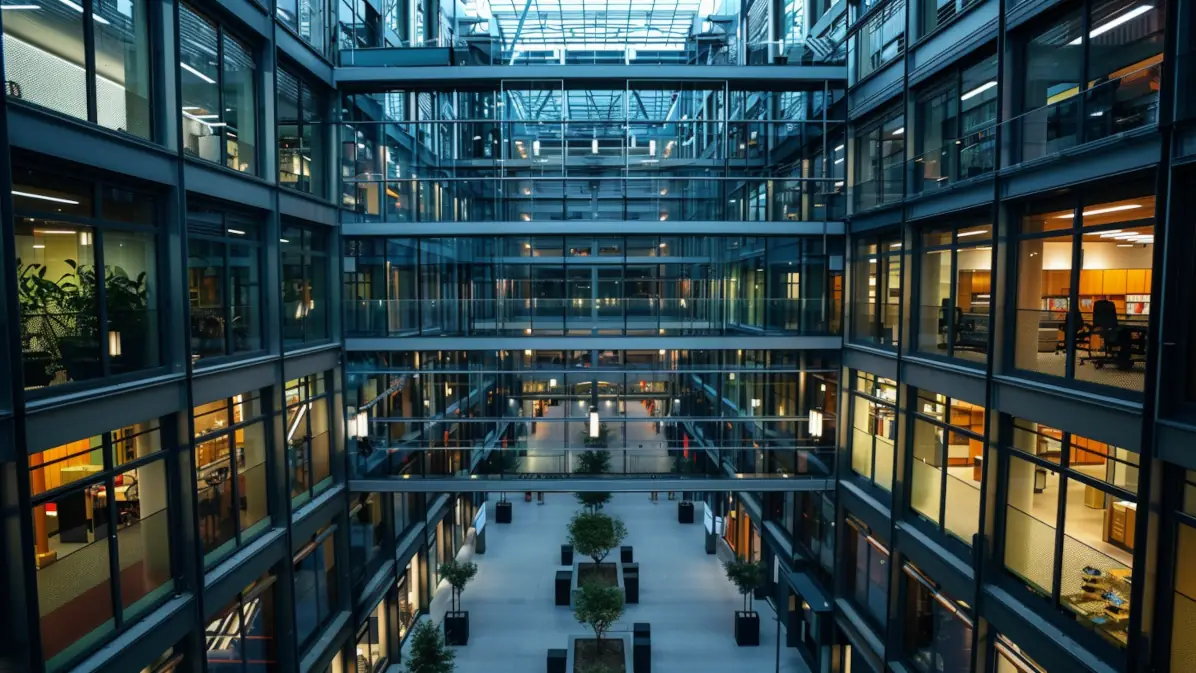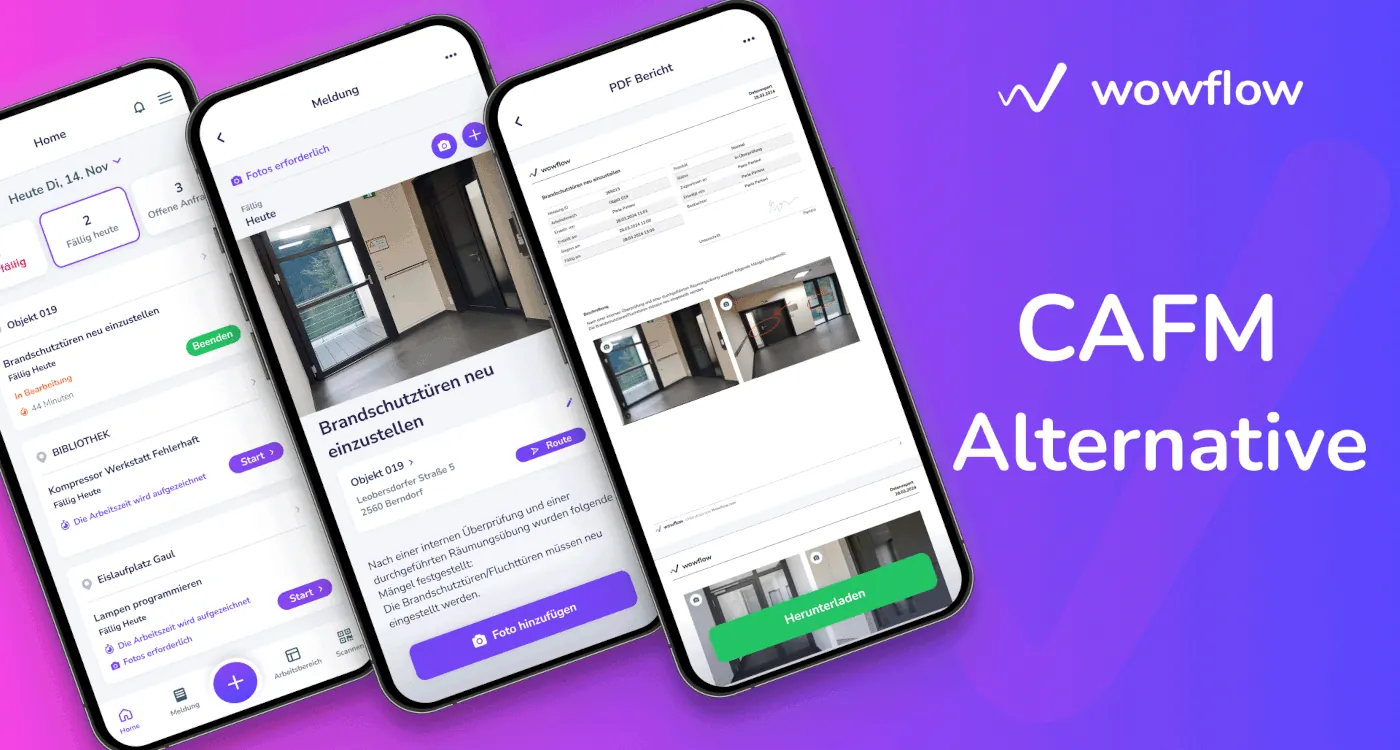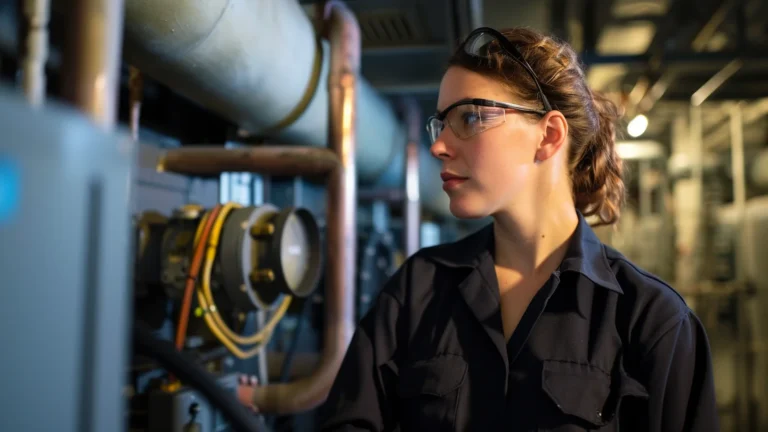What are the central building management tasks? This article guides you through the key areas – technical maintenance, infrastructural services, commercial management and space optimization. Find out how these tasks contribute to effective building management.
- Building management comprises technical, infrastructural and commercial tasks as well as space management, with each discipline contributing to increasing efficiency and reducing costs in operations.
- In the area of technical building management, compliance with legal regulations is crucial for safety and operability; optimizing energy efficiency is also essential for the sustainability of properties.
- Digital solutions such as BIM and CAFM improve data availability and process efficiency in building management and contribute to increasing energy efficiency and sustainability.
- Wowflow is a simple CAFM alternative that simplifies your facility management processes.
Building management: A brief definition

Building management is the control, operation and planning of a company’s buildings, facilities and working environments. It is a comprehensive concept that focuses on the optimal use of resources, ensuring safety and improving the working environment.
The main areas of building management are:
- Technical building management
- Infrastructural building management
- Commercial building management
- Space management
Each of these areas plays a specific role in the strategic planning of building management and supports the overall goal of ensuring efficient and effective operation.
Technical tasks in building management: core aspects and responsibilities

Technical building management includes:
- Ensuring the functionality and operability of the building
- the maintenance of the inventory, servicing and modernization measures
- guaranteeing the availability and functionality of the systems
Effective technical building management helps to reduce operating costs and extend the service life of technical systems.
Furthermore, technical building management contributes to legally compliant, safe use and supports energy savings and cost reduction. A proactive and optimized approach to technical building management can lead to a reduction in expensive breakdowns and repair costs and increase the satisfaction of tenants and owners.
Legal regulations and safety requirements
As part of technical building management, various standards, laws and regulations at EU, federal and state level must be observed. These are:
- Energy efficiency guidelines
- Fire protection regulations
- Occupational health and safety laws
- State waste laws
Compliance with these regulations is not only a legal obligation it also helps to ensure the safety of employees and support smooth operations.
Energy efficiency and sustainability

Energy efficiency and sustainability are key in today’s business world and technical building management plays a crucial role in achieving these goals. Building management strategies for CO₂ reduction are required by law and non-compliance can have significant financial consequences. Furthermore, buildings contribute significantly to the global carbon footprint and the aim is for all properties to achieve net zero emissions by 2050.
In order to achieve these goals, the focus is on substituting energy sources and exploiting potential savings, for example by using heat pumps in combination with photovoltaics.
Innovative solutions such as the networking of building systems and AI-supported analyses can help to maximize energy efficiency and promote sustainability, which ultimately contributes to increasing the value of the property.
Infrastructural tasks in building management: services and organization

Infrastructural building management is another key component of building management. It includes the following areas cleaning security and logistics as well as the furnishing and maintenance of communal areas. It also includes specific services and janitorial work.
- Your checklist for the janitor tour
- These are the tasks of a janitor (including PDF)
Other tasks in infrastructural building management include the administration of property management activities, interior furnishings and the exterior cleaning of buildings and the management of lost and found offices.
Facilities managers in infrastructural building management are also responsible for compliance with hygiene standards.
External service providers: selection and cooperation
Infrastructural building management often requires cooperation with external service providers. Performance and reliability are important criteria when selecting these service providers. In addition, decisions should be made on the basis of their experience and references in the field of infrastructural building management.
Collaboration with external service providers requires careful contract drafting in order to clearly define services, responsibilities and liability issues. In addition, it is important to regularly monitor the performance of external service providers and ensure clear communication in order to achieve the expected services and quality standards.
Our software offers all of this.
You can use the Wowflow app to cooperate with external service providers in facilities management without them using our software. Make an appointment for a product demo here.
Commercial tasks in building management: financial aspects and optimization

Commercial building management is another crucial aspect of building management. It includes accounting and cost management, including the correct allocation of costs and the preparation of service charge statements. Effective commercial building management helps to maximize the profitability of properties and minimize operating costs.
Commercial building management also includes contract management, which covers the preparation and administration of contracts as well as the checking, booking and payment of invoices and monitoring compliance with contractual obligations. Cost control plays a decisive role in the monitoring and targeted optimization of operating costs.
Real estate valuation and management
The valuation and management of real estate are central aspects of commercial building management. Property valuation is used to determine the market value of real estate for sale, purchase or accounting purposes. A precise understanding of the value of a property is crucial for strategic planning and decision-making in building management.
Property management also plays an important role in optimizing returns. This is achieved through strategic rental management and the reduction of administrative costs. Another important aspect of property management is the systematic recording and evaluation of rental income and expenditure in order to assess the profitability of the property.
Space management tasks: planning and use of premises

Space management focuses on the optimal use of existing space according to the operator’s requirements, the reduction of space requirements and the minimization of costs.
In addition to the pure management of an organization’s space inventory, space management also includes strategic space plans and the management of occupancy and relocation processes.
Modern technologies such as space management software and maturity models can support strategic decision-making and identify untapped potential.
A flexible room design allows for adaptations to business changes and zoning strategies to promote organization and efficiency. Employee retention can increase commitment and identification, while ergonomics and a pleasant environment increase job satisfaction.
Task planning: digital solutions for building management

As technology has advanced, digital solutions have become an integral part of building management. Tools such as Building Information Modeling (BIM) and Computer-Aided Facilities Management (CAFM) provide comprehensive data models and operational information that can significantly improve the efficiency and effectiveness of building management.
Companies such as Sartorius, Volkswagen and the BMW Group have already recognized the benefits of digitalization in building management and are benefiting from significant increases in efficiency and cost savings.
However, selecting the right CAFM software is difficult. We have therefore compiled an overview of CAFM providers compiled for you.
Innovative solutions such as AI-controlled building management and intelligent room planning software enable improved maintenance, monitoring and utilization of spaces while maximizing energy efficiency and sustainability.
Wowflow: CAFM alternative for your facility management
Wowflow is perfect for teams looking for a low-effort but powerful software to optimize their building management.
Wowflow makes it possible to structure task planning and coordination without lengthy implementation phases. The intuitive interface and quick familiarization phase also make it easy for external service providers and employees to use the platform without extensive training.
All in a centralized app that even offers offline functionalities and automatic translations – two essential features for supporting effective workflows.
Discover Wowflow – your efficient and user-friendly alternative to complicated CAFM systems. Save time, money and effort when managing your buildings and systems.
Start today for free, without a credit card and obligations.
Role of the building manager in building management

Building managers play a crucial role in the complex landscape of building management. These experts are responsible for
- the comprehensive management of the building
- the coordination of personnel deployment
- monitoring the condition of the buildings
- support for both tenants and landlords
Facility managers are true multitaskers in their field.
A facility manager needs a wide range of skills, from commercial to technical to manual skills. They are also responsible for ensuring compliance with legal requirements and estimating operating costs.
These extensive requirements make the role of facility manager a unique and indispensable position in building management.
Summary
Facility management is a complex but crucial task in the modern business world. It covers a wide range of aspects, from the technical and infrastructural maintenance and management of buildings and facilities to the efficient use of space and the introduction of digital solutions to improve efficiency and reduce costs.
The facility manager plays a decisive role here and must have a broad range of skills. Wowflow offers a simple solution for your building and facility management.
Increase your efficiency in facilities management with Wowflow.
Frequently asked questions
What is commercial building management?
Commercial building management includes bookkeeping, cost accounting and contract organization for the maintenance of buildings. These tasks also include the administration of contracts and utility bills.
What does the Building Management Office do?
The Office for Building Management is responsible for the planning, implementation and renovation of buildings as well as the purchase, sale and management of properties. It takes on all tasks in the life cycle of the managed properties.
What is building management?
Building management is a part of facilities management and deals with the management of buildings and technical facilities in order to keep them in the best possible condition and ensure that they are fit for purpose.




